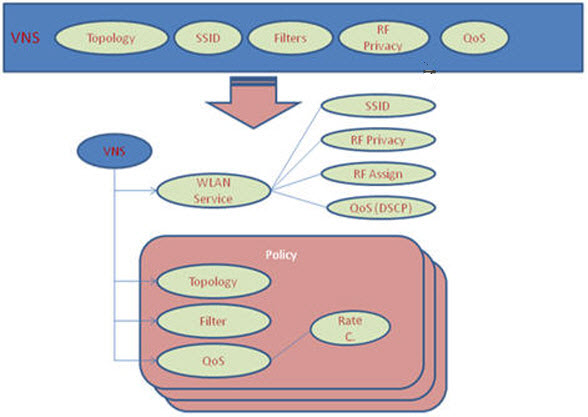Virtual Network Services (VNS) provide a versatile method of mapping wireless networks to the topology of an existing wired network.
In releases prior to V7.0, a VNS was a collection of operational entities. Starting with Release V7.0, a VNS becomes the binding of reusable components:
The following figure illustrates the transition of the concept of a VNS to a binding of reusable components.

WLAN Service components and Role components can be configured separately and associated with a VNS when the VNS is created or modified. Alternatively, they can be configured during the process of creating a VNS.
Additionally, Roles can be created using the Extreme Networks Extreme Management Center Policy Manager or Extreme Management Center Wireless Manager and pushed to the ExtremeWireless Appliance. Role assignment ensures that the correct topology and traffic behavior are applied to a user regardless of WLAN service used or VNS assignment.
When VNS components are set up on the controller, among other things, a range of IP addresses is set aside for the controller‘s DHCP (Dynamic Host Configuration Protocol) server to assign to wireless devices.
If the OSPF routing protocol is enabled, the controller advertises the routed topologies as reachable segments to the wired network infrastructure. The controller routes traffic between the wireless devices and the wired network.
The controller also supports VLAN-bridged assignment for VNSs. This allows the controller to directly bridge the set of wireless devices associated with a WLAN service directly to a specified core VLAN.
VNS and WLANS Capacity
| Controller Model | Max Number of Defined VNS | Max Number of Defined WLAN Services | Max Number of Active WLAN Services |
|---|---|---|---|
| C5110 | 256 | 256 | 128 |
| C4110 | 128 | 128 | 64 |
| C25 | 32 | 32 | 16 |
| V2110 Small | 32 | 32 | 16 |
| V2110 Medium V2110-HyperV |
128 | 128 | 64 |
| V2110 Large | 256 | 256 | 128 |
| C5210 | 256 | 256 | 128 |
| C35 | 32 | 16 | 32 |
The AP radios can be assigned to each of the configured WLAN services and, therefore, VNSs in a system. Each AP can be the subject of 16 service assignments—eight assignments per radio—which corresponds to the number of SSIDs it can support. Once a radio has all eight slots assigned, it is no longer eligible for further assignment.
The AP3912 has three additional client ports that can be assigned to a single WLANS. For more information, see Assigning WLAN Services to AP3912 Ports.